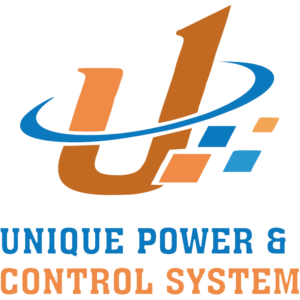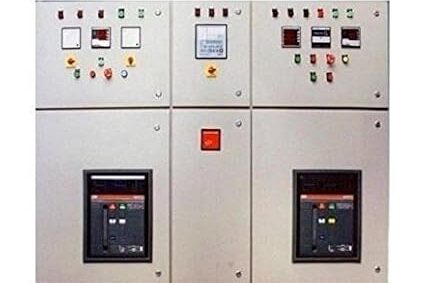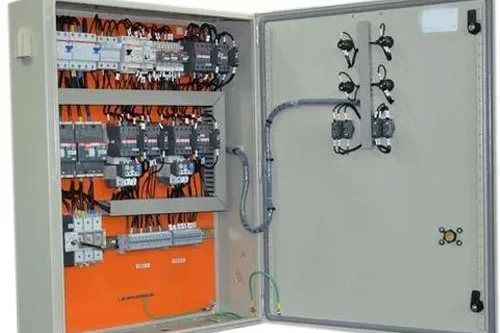
APFC PANEL
An APFC panel (Automatic Power Factor Correction panel) is an electrical control system used to improve the power factor of a power distribution network. Power factor is a measure of how effectively electrical power is being used, and improving it can lead to more efficient energy use, reduced electricity bills, and better voltage regulation in the power system.
Key Functions of a APFC Panel:
- Automatic Power Factor Correction: The primary function of an APFC panel is to automatically correct the power factor by switching capacitor banks in and out of the circuit as needed. This is done in response to the varying reactive power demand in the system.
- Energy Efficiency: By improving the power factor, APFC panels reduce the amount of reactive power (which does not perform any useful work) in the system, leading to more efficient use of electrical energy and potentially lower energy costs.
- Reduction of Penalties: Many utility companies charge penalties if the power factor falls below a certain threshold (usually 0.9). An APFC panel helps avoid these penalties by maintaining a higher power factor.
- Voltage Regulation: APFC panels help stabilize the voltage levels within the power distribution system by reducing the reactive power, which can cause voltage drops.
- Harmonic Filtration (Optional): Some advanced APFC panels are equipped with harmonic filters to reduce harmonic distortion in the electrical system, further improving power quality.
In an APFC (Automatic Power Factor Correction) panel, various electrical abbreviations and symbols are used to represent different components and functions. These are essential for understanding electrical diagrams and ensuring proper operation and maintenance of the panel.
PF – Power Factor
APFC – Automatic Power Factor Correction
V – Voltage
A – Ampere (Current)
CT – Current Transformer
CB – Circuit Breaker
OLR – Overload Relay
kVAR – Kilovolt-Ampere Reactive (Reactive Power)
kW – Kilowatt (Active Power)
MCCB – Molded Case Circuit Breaker
MCB – Miniature Circuit Breaker
RMS – Root Mean Square (value of voltage or current)
THD – Total Harmonic Distortion
LV – Low Voltage
MV – Medium Voltage
HV – High Voltage
SPD – Surge Protection Device
TP – Triple Pole (Switches, Circuit Breakers)
TPN – Triple Pole with Neutral
DP – Double Pole
DPDT – Double Pole Double Throw (Switch)
NO – Normally Open (Contact)
NC – Normally Closed (Contact)
HMI – Human Machine Interface
PLC – Programmable Logic Controller
PC – Power Capacitor
PT – Potential Transformer
Capacitor Symbol:Represents the capacitors used in the panel to correct the power factor.
Contactor Symbol:Represents the contactors that switch capacitor banks in and out of the circuit.
Automatic Power Factor Controller (APFC) Relay Symbol:Represents the APFC relay that controls the switching of capacitor banks based on power factor readings.
Current Transformer (CT) Symbol:Represents the CTs that measure current in the system and provide inputs to the APFC relay.
Circuit Breaker Symbol:Represents the circuit breakers that protect the panel and connected circuits from overcurrent.
Fuse Symbol:Represents fuses used for overcurrent protection.
Overload Relay (OLR) Symbol:Represents overload relays that protect the panel from excessive current by disconnecting the circuit when necessary.
Voltage Measurement Symbol:Represents voltage measurement points or devices in the panel.
Power Factor Meter Symbol:Represents a device that measures the power factor in the system.
Ground/Earth Symbol:Represents the grounding connection for safety.
HMI (Human Machine Interface) Symbol:Represents the interface used for monitoring and controlling the APFC panel.
Surge Protection Device (SPD) Symbol:Represents a device that protects the panel from voltage spikes.
Terminal Block Symbol:Represents connection points for wiring within the panel.
Voltage Transformer (VT) Symbol:Represents a transformer used to measure voltage and provide it to the APFC relay.
Neutral Link Symbol:Represents the neutral connection in the panel.
Indicating Lamp Symbol:Represents status indicators like ON/OFF or Fault.
Fan Symbol:Represents the cooling fans used in the panel to prevent overheating.
APFC (Automatic Power Factor Correction) panels are used to manage and improve the power factor of electrical systems. Improving power factor is crucial for optimizing energy usage, reducing electricity costs, and ensuring efficient operation of electrical equipment. Here’s a detailed look at where and why APFC panels are used:
1.Industrial Plants:
Machinery and Equipment: APFC panels are employed to correct the power factor of large motors, transformers, and other inductive loads commonly found in manufacturing plants. By improving power factor, they help reduce the load on the electrical distribution system and improve overall energy efficiency.
Energy Savings: They help in reducing energy costs by minimizing the amount of reactive power drawn from the grid, which can lead to lower electricity bills and avoidance of power factor penalties.
2.Commercial Buildings:
HVAC Systems: Large commercial buildings with extensive heating, ventilation, and air conditioning (HVAC) systems benefit from APFC panels. These systems often have large motors that can significantly impact power factor, so correction panels help in maintaining efficient operation and reducing energy consumption.
Lighting Systems: In buildings with high-intensity lighting systems, APFC panels correct the power factor to ensure that lighting fixtures operate efficiently without causing excessive reactive power.
3.Power Distribution Networks:
Grid Stability: APFC panels are used in power distribution networks to stabilize voltage levels and improve power quality by managing reactive power. This helps in ensuring a reliable and efficient power supply to end-users.
Reactive Power Compensation: They provide reactive power compensation, reducing the burden on transformers and generators, and improving the overall efficiency of the power distribution system.
4.Data Centers:
Equipment Efficiency: Data centers with numerous servers, cooling systems, and other electrical equipment use APFC panels to correct power factor, ensuring that the power supply is utilized efficiently and reducing energy costs.
Voltage Regulation: They help in maintaining voltage stability, which is critical for the reliable operation of sensitive IT equipment.
5.Renewable Energy Systems:
Wind and Solar Farms: APFC panels are used in renewable energy systems to manage the power factor and ensure that the generated power is efficiently integrated into the grid. This helps in optimizing the performance of renewable energy sources and reducing energy losses.
Reactive Power Management: They help in balancing reactive power in systems where the generation and consumption of reactive power can fluctuate.
6.Agricultural Facilities:
Irrigation Systems: APFC panels correct the power factor in agricultural irrigation systems that use large pumps and motors. This helps in reducing the energy costs associated with pumping and irrigation operations.
Grain Handling: They are used in facilities with grain handling equipment, such as conveyors and dryers, to improve power factor and operational efficiency.
7.Steel and Metal Industry:
Rolling Mills and Furnaces: In steel and metal industries, where large motors and induction furnaces are used, APFC panels help in correcting power factor to ensure efficient operation and reduce electrical losses.
Energy Efficiency: They improve the overall energy efficiency of the plant, leading to cost savings and better performance of equipment.
8.Paper and Pulp Industry:
Processing Equipment: APFC panels are used to manage the power factor of equipment such as pulping machines, paper mills, and drying systems. This helps in reducing energy consumption and improving the efficiency of the manufacturing process.
Reduced Penalties: By maintaining a high power factor, APFC panels help avoid penalties imposed by utilities for low power factor.
9.Pharmaceutical Industry:
Cleanroom Systems: In pharmaceutical manufacturing, where cleanrooms and controlled environments are critical, APFC panels ensure that HVAC systems and other equipment operate efficiently with improved power factor.
Process Equipment: They help in managing the power factor of various process equipment used in drug production, ensuring reliable and efficient operations.
10.Transportation Systems:
Railways: APFC panels are used in railway systems to manage the power factor of signaling systems, track switches, and other motor-driven equipment, improving the efficiency and reliability of rail operations.
Airports: In airport facilities, APFC panels correct the power factor of baggage handling systems, lighting, and other electrical systems to optimize energy use and reduce costs.
Benefits of Using APFC Panels:
Energy Efficiency: By improving the power factor, APFC panels reduce the overall energy consumption, leading to cost savings and better utilization of electrical power.
Reduced Electricity Bills: Lower power factor can result in higher electricity costs due to penalties imposed by utilities. APFC panels help avoid these penalties by maintaining an optimal power factor.
Improved Voltage Stability: Better power factor helps in maintaining stable voltage levels, which is crucial for the reliable operation of electrical equipment.
Extended Equipment Life: By reducing the reactive power load on transformers, generators, and other equipment, APFC panels help in extending their operational life and reducing maintenance needs.
Enhanced Power Quality: APFC panels contribute to improved power quality by managing reactive power and reducing voltage drops and fluctuations in the electrical system.
In summary, APFC panels are essential for managing power factor in various applications, leading to energy savings, reduced costs, and improved efficiency in electrical systems.















